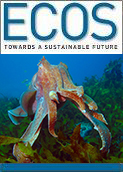
|
Published: 18 September 2013
Penny Whetton: Climate change science in focus
With the Intergovernmental Panel on Climate Change (IPCC) about to deliver the first of its Fifth Assessment reports in Stockholm next week, ECOS talks climate science with Dr Penny Whetton, a Senior Principal Research Scientist in the Climate Projections Science Team at CSIRO Marine and Atmospheric Research in Victoria, and leader of the Climate Projections for Natural Resource Management project in the Climate Adaptation Flagship.

|
|
Sunset with wires: Dr Whetton, an atmospheric physicist and a lead author of three previous IPCC Working Group reports, is also a keen photographer. Credit:
P. Whetton/flickr
|
What does your job entail?
I work at the interface between global climate change modelling and applying that knowledge to assess how climate change might impact regional agriculture, ecosystems, hydrology and so on.
I have been the main contributor to, and editor of, CSIRO's Australian climate change projections released in 1992, 1996, 2001 and the projections released by CSIRO and the Bureau of Meteorology in 2007, which have progressively consolidated our understanding of how Australian climate is likely to change in coming decades. I have also been the lead author of three IPCC Working Group reports.
How did your interest in climate science come about?
My undergraduate background was in physics, and when it came to choosing a subject for my honours year, I wanted to apply my physics background to something practical so chose to focus on weather and climate. This led to a PhD in climate variability and later to CSIRO, where I have worked in future climate change for 24 years.
What has been the highlight of your career so far?
The highlight would have to be my involvement in the IPCC, where I have worked on three successive reports. These reports involve collaborating with the best scientists in the world in my field to create a report that has great impact and is highly significant; intellectually, it is also very stimulating. The IPCC (with Al Gore) was jointly awarded the Nobel Peace Prize in 2007.
In 2001 (IPCC Third Assessment Report) and 2007 (IPCC Fourth Assessment Report) I worked on the climate science (Working Group I) report.
However, for the Fifth Assessment Report – which will include Working Group I’s report Climate Change 2013: The Physical Science Basis to be published this month, and Working Group II’s report Climate Change 2014: Impacts, Adaptation, and Vulnerability to be published in April 2014 – I was able to cross the boundary and work on the ‘Impacts’ report because my research has always been at the interface of science and impacts.
What is the greatest challenge you face in your research?
A climate projection scientist’s greatest challenge is trying to reduce uncertainty around projections for climate change.
Some things we know with great certainty, such as future increases in temperature. But when it comes to predicting what impact climate change will have on summer rainfall in northern Australia, for example, there is currently inconsistency in global models and we are still trying to work out which outcome – whether more or less rainfall – is most likely. In southern Australia we can speak with more certainty; we are expecting winter declines in rainfall.
The other challenge is the communication of climate change information. Climate varies naturally, as well as due to human influence. Helping people distinguish between natural changes and forced ones, both in the past and in the future, is not always easy, especially for rainfall.
Also, because responding to the threat posed by climate change is challenging for society, we are conveying a message that people don’t necessarily want to hear.
Can you highlight ‘game changing’ moments in climate science since the IPCC4 report in 2007? Have they changed thinking or confirmed earlier predictions?
Just as CSIRO’s projections have provided a consolidation of the message that future climate in Australia will be warmer, the science since the IPCC report in 2007 has primarily provided further confirmation of the message of that report, rather than causing ‘game changes’. In particular, the new round of climate modelling, which is much more extensive than that available in 2007, is telling the same story that the earlier models told.
What will you be discussing at Greenhouse 2013 in October, and why are events like this so valuable?
I will be presenting an update on projections for Australia, based on the latest global climate models, and how to tailor these to meet the needs of natural resource managers. This information will help them revise their future management plans so that they can take climate change projections into account.
The Greenhouse conferences have been running since 1987, and for many years they were one of the few conferences in the world focusing exclusively on the science of climate change and its effects. They have really led the way for the range of climate science events held around the world today.
What key messages about climate change and the science would you like to see better understood and communicated in the public arena?
There is a lot of certainty around climate change, but what is often emphasised is uncertainty.
It is true that there are some aspects of future regional climate that aren’t clear, but there is no serious scientific doubt of the prognosis of a significantly warmer planet, and if people come across information that suggests otherwise, it wouldn’t pass the test of science. Getting some people to understand this is a real challenge.
How do you relax and switch off from work?
I’m a keen photographer and have recently taken up painting. I also enjoy reading history.



